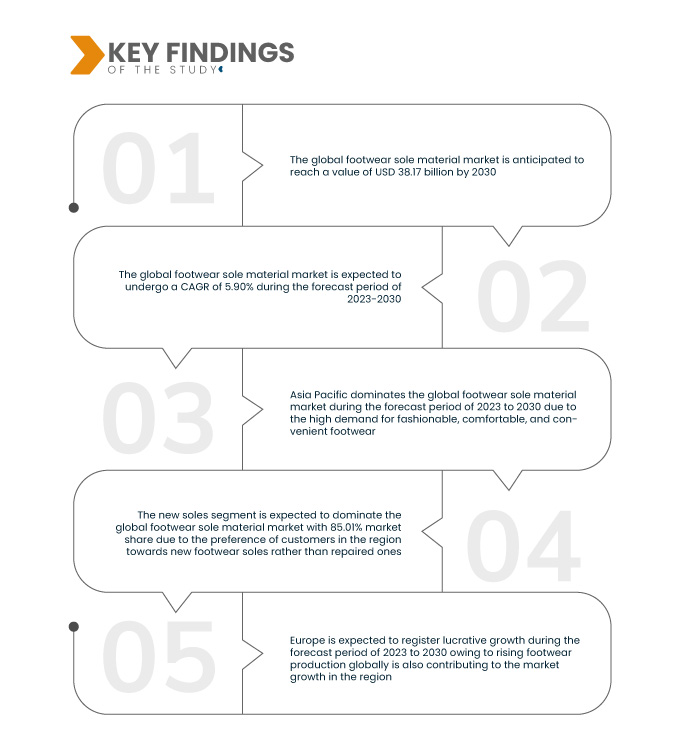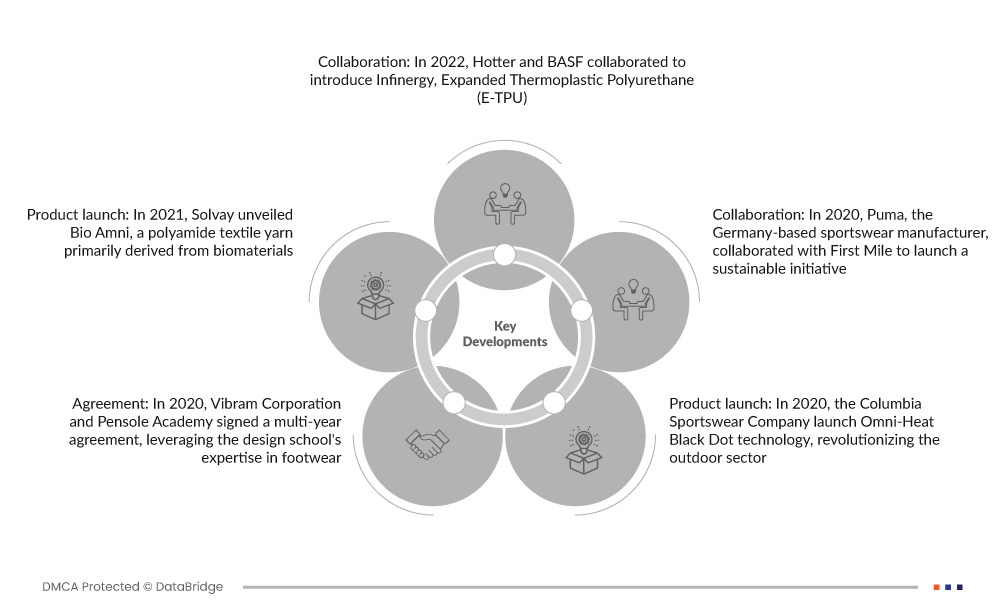Footwear sole material refers to the substances used in creating the bottom part of a shoe, providing support, comfort, durability, and traction. Common materials include rubber, thermoplastic elastomers (TPE), polyurethane (PU), ethylene-vinyl acetate (EVA), leather, and combinations of these. Each material offers unique properties such as flexibility, shock absorption, water resistance, or abrasion resistance. The choice of sole material depends on the intended purpose of the footwear, such as sports, fashion, or work-related uses, and directly impacts performance, cushioning, and safety. Innovative sole technologies and sustainable materials are gaining prominence to improve functionality and environmental responsibility.
Access Full Report @ https://www.databridgemarketresearch.com/reports/global-footwear-sole-material-market
Data Bridge Market Research analyzes that the Global Footwear Sole Materials Market is expected to reach USD 36.41 billion by 2031 from USD 24.47 billion in 2023, growing with a substantial CAGR of 5.31% in the forecast period of 2024 to 2031.
Key Findings of the Study
Innovation in Eco-Friendly Materials
The global footwear sole materials market is experiencing transformative growth fueled by innovations in eco-friendly materials that address rising consumer demand for sustainability and stringent environmental regulations. With heightened global environmental awareness, both businesses and consumers are gravitating toward biodegradable, recyclable, and renewable materials such as thermoplastic polyurethanes (TPUs), plant-based alternatives like bacterial cellulose, and bio-polymers. This shift, supported by regulatory incentives and policies from entities like Japan's Ministry of Economy, Trade and Industry and the U.S. Consumer Product Safety Commission, is driving companies to replace conventional petrochemical-based soles with sustainable options, reducing carbon emissions and landfill waste. Furthermore, leading brands are investing in advanced manufacturing technologies, including 3D printing and bio-based compound processing, to achieve precise, resource-efficient production while minimizing waste. The adoption of these innovative, eco-friendly materials not only enhances corporate sustainability but also provides a competitive edge by aligning with evolving consumer expectations and regulatory standards.
Report Scope and Market Segmentation
|
Report Metric
|
Details
|
|
Forecast Period
|
2024 to 2031
|
|
Base Year
|
2023
|
|
Historic Years
|
2022 (Customizable to 2016 - 2021)
|
|
Quantitative Units
|
Revenue in USD Billion
|
|
Segments Covered
|
Product (Polyurethane, Rubber, SBS/Thermoplastic Elastomeric Block Copolymers, EVA, PVC, and Bio-Materials), Sole Component (Innersole and Outsole), Sole Product (New Soles and Repair Soles), Application (Athletic and Non-Athletic), End-User (Men, Women, and Kids)
|
|
Countries Covered
|
U.S., Canada, China, India , Japan, South East Asia, South Korea, Australia & New Zealand, Rest of Asia-Pacific, Germany, U.K., France , Italy, Portugal, Spain, Russia, Switzerland, Turkey, Belgium, Netherlands, Luxemburg, Rest of Europe, Brazil, Argentina Mexico, Peru, Chile, Ecuador, Rest of Latin America, South Africa, Egypt, Saudi Arabia, United Arab Emirates, Israel, Rest of Middle East and Africa
|
|
Market Players Covered
|
Huntsman International LLC. (U.S), DOW (U.S), Solvay (Belgium), INOAC CORPORATION (Japan), Asahi Kasei Corporation. (Japan), BASF(Germany), Covestro AG (Germany), TP Polymer Private Limited (India), and inpvc (China)
|
|
Data Points Covered in the Report
|
In addition to the insights on market scenarios such as market value, growth rate, segmentation, geographical coverage, and major players, the market reports curated by the Data Bridge Market Research also include in-depth expert analysis, geographically represented company-wise production and capacity, network layouts of distributors and partners, detailed and updated price trend analysis and deficit analysis of supply chain and demand.
|
Segment Analysis
The global footwear soles market is segmented into six notable segments based on type, mode of action, form, application, crop type, and distribution channel.
- On the basis of product, the market is segmented into polyurethane, rubber, SBS/thermoplastic elastomeric block copolymers, EVA, PVA, and bio-materials
In 2024, the polyurethane segment is expected to dominate the market with a market share of 45.37%
In 2024, the polyurethane segment is expected to dominate the market with a market share of 45.37% due to its superior properties, such as high durability, flexibility, lightweight nature, and excellent shock absorption. Polyurethane offers versatility in design, making it suitable for various types of footwear, including athletic, casual, and safety shoes.
- On the basis of sole component, the market is segmented into innersole and outsole
In 2024, the innersole segment is expected to dominate the market with a market share of 70.48%
In 2024, the innersole segment is expected to dominate the market with a market share of 70.48% due to increasing consumer demand for enhanced comfort, cushioning, and foot support across various footwear categories. Innovations in innersole technology, such as memory foam, gel inserts, and orthotic designs, are driving the focus on personalized comfort and improved ergonomics. Rising health and wellness trends, coupled with growing awareness about foot health, are further fueling demand for high-performance innersoles.
- On the basis of sole product, the market is segmented into new soles and repair soles. In 2024, the new soles segment is expected to dominate the market with a market share of 85.85%
- On the basis of application, the market is segmented into athletic and non-athletic. In 2024, the organic segment is expected to dominate the market with a market share of 55.92%
- On the basis of end-user, the market is segmented into men, women and kids. In 2024, the men segment is expected to dominate the market with a market share of 46.39%
Major Players
Data Bridge Market Research analyzes Asahi Kasei Corporation (Japan), DOW (U.S), Covestro AG (Germany), BASF(Germany), Huntsman International LLC. (U.S) as major market players.
Market Developments
- In September 2023, BASF showcased innovative and sustainable solutions for the footwear industry under the theme "Say hello to the Footure!" at Simac Tanning Tech 2023. Key highlights included the mechanical recycling of PU waste to create new soles, new PU-based technologies for more comfortable and lightweight insoles, and advancements in Infinergy E-TPU for energy return. BASF also demonstrated how combining traditional processes with 3D printing can result in futuristic footwear designs
- In October 2024, Dow and Ambipar expanded their strategic alliance to revolutionize plastic recycling in Brazil, aiming to increase polyethylene recycling from 2,000 to 60,000 tons annually by 2030. Their partnership focuses on transforming post-consumer waste into valuable products for a circular economy
- In September 2024, Covestro announced the construction of a new Thermoplastic Polyurethanes (TPU) Application Development Center in Guangzhou, South China, following last year's launch of its largest TPU plant in Zhuhai. This center aims to enhance customer collaboration by integrating technical expertise with innovative solutions for key applications such as films, specialty cables, consumer electronics, and footwear
- In August 2024, Huntsman launched AVALON Gecko TPU, an advanced thermoplastic polyurethane designed for footwear applications. This innovative material offers superior slip-resistance, enhanced durability, and comfort, making it ideal for athletic, outdoor, and professional footwear. The launch strengthens Huntsman’s position in the footwear market, providing manufacturers with a high-performance, eco-friendly solution that meets both functional and aesthetic demands, while expanding the company’s portfolio in the growing TPU segment
- In April 2024, Solvay inaugurated a new Alve-One blowing agent production unit in Rosignano, Italy, aimed at transforming the thermoplastic foaming industry. This eco-designed agent offers sustainability benefits by reducing carbon footprints in applications like automotive, footwear, and construction. The launch supports Solvay's commitment to delivering innovative and environmentally friendly solutions, helping customers meet evolving demands for safer, more sustainable products
Regional Analysis
Geographically, the countries covered in the Europe water purifier market report are U.S., Canada, China, India , Japan, South East Asia, South Korea, Australia & New Zealand, rest of Asia-Pacific, Germany, U.K., France , Italy, Portugal, Spain, Russia, Switzerland, Turkey, Belgium, Netherlands, Luxemburg, rest of Europe, Brazil, Argentina Mexico, Peru, Chile, Ecuador, rest of Latin America, South Africa, Egypt, Sausdi Arabia, United Arab Emirates, Israel, and rest of Middle East and Africa.
As per Data Bridge Market Research analysis:
Asia-Pacific is the dominant region in global footwear soles market
In 2024, the Asia-Pacific region is expected to dominate market due to its large manufacturing base, cost-effective production capabilities, and the presence of numerous key market players.
Asia- Pacific is estimated to be the fastest-growing region in global footwear soles market
Rapid urbanization, growing disposable incomes, and increased consumer demand for both athletic and casual footwear in countries such as China, India, and Vietnam further contribute to market growth.
For more detailed information about Global footwear soles market report, click here – https://www.databridgemarketresearch.com/reports/global-footwear-sole-material-market












